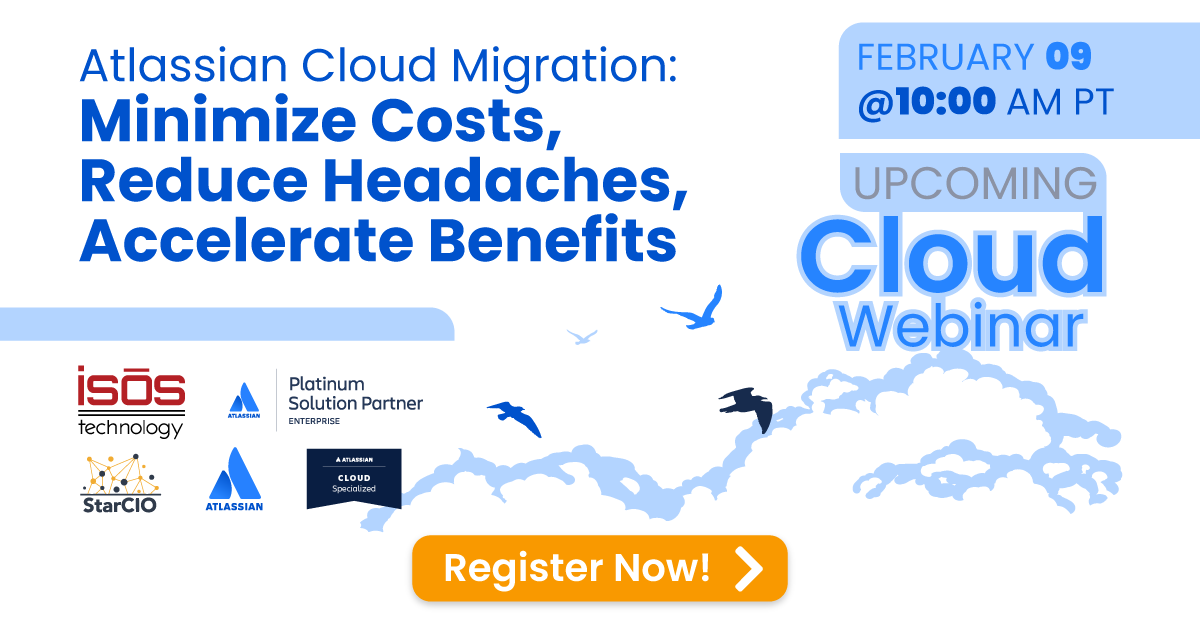Guest Contributor: Isaac Sacolick, President | CIO, StarCIO

Atlassian announced the February 2, 2024 end of life for Atlassian Server Products, including Jira Software Server, Jira Core Server, Jira Service Management Server, and Confluence Server. IT teams have to decide what’s best for them – either migrating to Atlassian Cloud or Atlassian Data Center.
We’ll be exploring migration dos and don’ts in the webinar, Atlassian Cloud Migration: Minimize Costs, Reduce Headaches, Accelerate Benefits. Needless to say, migrating isn’t straightforward because Atlassian tools, especially Jira Software, Jira Service Management, and Confluence, are the central nervous system of innovative and service-oriented IT organizations. A migration offers many benefits to end users, but has speed bumps for organizations with custom configurations and third-party integrations.
A migration is the perfect time to clean house and help agile development and IT Ops consolidate to a few templated configurations. More on that in the webinar!
But for now, you might be wondering what the advantages of migrating are, and why IT departments should plan to migrate sooner rather than later. A recent Forrester report on the total economic impact of Atlassian Cloud quantifies the cost benefits of a migration. And speaking to expert users shows where their organizations see immediate and longer-term benefits.
So, if you’re asked to quantify the ROI of a migration or outline its benefits, here are five places to look.
1. Reduce Tickets Tied to Supporting Atlassian Server
According to the Forrester report, ITSM teams saw a 90% drop in tickets tied to supporting Atlassian products once they migrated to Atlassian Cloud. Furthermore, they were able to resolve the remaining tickets 38% faster. For organizations seeing fifty tickets a month, Forrester estimates that they can save over $1 million over three years in productivity improvements.
The report provides the formulas so that you can plug in your organization’s ticket volumes and assumptions on improvements. Migrating to Atlassian Cloud implies that tickets tied to infrastructure and access can be eliminated or reduced significantly. Tickets tied to configuration are often self-service in the latest versions of Atlassian’s products, and others can be resolved faster with the latest and greatest admin UI upgrades.
2. Eliminate Infrastructure Refresh Costs
The Forrester report provides the calculations on the costs for hardware, software, and maintenance costs for Jira Server compared to deploying and running the equivalent products in Atlassian Cloud. There are many variables tied to computing these costs, including the number of physical instances, architecture, and usage, so you’d have to go through your analysis to compute the present and future state costs.
Astute readers will recognize that the costs of running Atlassian products in Cloud or Data Center net out over three years, plus or minus a percentage factor depending on your assumptions. This is one reason some companies will review both Atlassian Data Center and Atlassian Cloud options.
But the real lesson here is to work with a partner to help assess hosting costs and provide you with the best options for your organization’s migration.
3. Let Atlassian Handle the Product Upgrades
When you host the technology yourself, you own all the steps to upgrade to the latest versions and fast-track the security patches. Atlassian upgrades its products frequently, and there were seven releases of Jira Software in 2021 (8.15 to 8.21 plus three patch releases) and another six releases of Jira Service Management (4.15-4.21). If your organization uses Confluence Server and other hosted products, then factor in these upgrades.
Administering these upgrades takes IT time to review, schedule, and execute. And if you have multiple Server instances in different data centers or geographies, these also need to be upgraded individually.
You can model these costs, but many organizations just can’t keep up with the upgrades and end up running on outdated versions. Atlassian Cloud is a SaaS operating model, so all the work to perform upgrades is no longer consuming IT’s time.
4. Improve Productivity with the Latest Features and Enhancements
A byproduct of falling behind versions is that the latest capabilities and enhancements are not available to agile and IT Ops teams. The impact is hard to quantify and depends on how far behind your organization is in upgrading and how many teams take advantage of new capabilities.
But the missing features add up over time and increase user frustration when they read about enhancements they can’t utilize. That can be a big hit on developer happiness or impact ITSM’s KPIs at a time when hybrid working and retaining employees are business issues.
What are you missing? In 2021, Jira Software enhancements included search improvements, security enhancements, and a refreshed commenting experience. JSM’s 2021 releases included customer portal upgrades, mobile support for service projects, and performance improvements to event processing.
When you’re going to have to migrate, scheduling it sooner rather than later means teams get access to these capabilities, plus all the new features Atlassian releases.
5. Drive Innovation with Advanced Roadmaps
Releases provide fixes, enhancements, and new features. And sometimes, a release includes game-changing functionality that can dramatically change IT practices and capabilities.
Advanced Roadmaps in Jira Software is one of those features. Agile development teams can work through the details of releases and sprints through the backlog and active boards, while business leaders can see a top-down timeline view of versions, epics, features, and stories using Advanced Roadmaps. More advanced agile organizations with product management functions can also consider expanding to Jira Align.
JSM also has its list of breakthrough capabilities, including asset and configuration management. Both products also include native automation features. For organizations in competitive industries, leaving these capabilities behind can stymie innovation, productivity, and quality!
So, migration has a cost, as well as productivity and capabilities benefits. Tune into the webinar to learn more about minimizing costs, reducing headaches, and accelerating the benefits of migrating to Atlassian Cloud.
Isaac Sacolick, President of StarCIO, guides companies through smarter, faster, innovative, and safer digital transformation programs that deliver business results. He is the author of the Amazon bestseller, Driving Digital: The Leader’s Guide to Business Transformation through Technology, an industry speaker, and blogger at Social, Agile, and Transformation. StarCIO offers three agile planning courses for stakeholders, teammates, and certified StarCIO Agile Planners.
Sign up to receive more great content
Learn more about Atlassian and how Isos can help by signing up to receive our latest blogs, eBooks, whitepapers and more.














